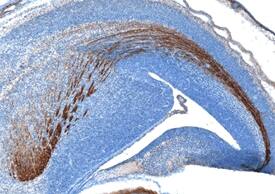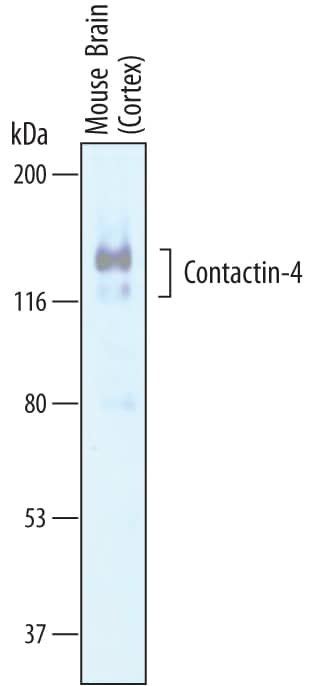Mouse Contactin-4 Antibody
R&D Systems, part of Bio-Techne | Catalog # AF5495

Key Product Details
Species Reactivity
Validated:
Cited:
Applications
Validated:
Cited:
Label
Antibody Source
Product Specifications
Immunogen
Asp19-Gly999 (Ile64Leu)
Accession # Q69Z26
Specificity
Clonality
Host
Isotype
Scientific Data Images for Mouse Contactin-4 Antibody
Detection of Mouse Contactin‑4 by Western Blot.
Western blot shows lysates of mouse brain (cortex) tissue. PVDF Membrane was probed with 2 µg/mL of Sheep Anti-Mouse Contactin-4 Antigen Affinity-purified Polyclonal Antibody (Catalog # AF5495) followed by HRP-conjugated Anti-Sheep IgG Secondary Antibody (Catalog # HAF016). Specific bands were detected for Contactin-4 at approximately 135 kDa (as indicated). This experiment was conducted under reducing conditions and using Immunoblot Buffer Group 1.Contactin‑4 in Mouse Brain.
Contactin-4 was detected in perfusion fixed frozen sections of mouse brain (15 d.p.c.) using Sheep Anti-Mouse Contactin-4 Antigen Affinity-purified Polyclonal Antibody (Catalog # AF5495) at 15 µg/mL overnight at 4 °C. Tissue was stained using the Anti-Sheep HRP-DAB Cell & Tissue Staining Kit (brown; Catalog # CTS019) and counterstained with hematoxylin (blue). Specific staining was localized to neuronal processes. View our protocol for Chromogenic IHC Staining of Frozen Tissue Sections.Applications for Mouse Contactin-4 Antibody
Immunohistochemistry
Sample: Perfusion fixed frozen sections of mouse brain (15 d.p.c.)
Western Blot
Sample: Mouse brain (cortex) tissue
Formulation, Preparation, and Storage
Purification
Reconstitution
Formulation
Shipping
Stability & Storage
- 12 months from date of receipt, -20 to -70 °C as supplied.
- 1 month, 2 to 8 °C under sterile conditions after reconstitution.
- 6 months, -20 to -70 °C under sterile conditions after reconstitution.
Background: Contactin-4
Contactin-4 (CNTN4), also known as BIG-2 (brain-derived immunoglobulin superfamily molecule 2), is an axonal cell adhesion molecule (AxCAM) that belongs to the contactin family, a subfamily of the Ig superfamily (1, 2). The contactin family comprises six members (CNTN1/F3, CNTN2/TAG-1, CNTN3/BIG-1, CNTN4/BIG-2, CNTN5/NB-2 and CNTN6/NB-3) that are characterized by the presence of six Ig like domains, four fibronectin type III-like repeats, and a glycosylphosphatidylinositol (GPI)-anchoring domain (1‑4). Contactins are membrane-anchored proteins that can be released as soluble proteins by GPI-specific phospholipase D and are able to promote neurite outgrowth in their soluble form (2). Potential 1026, 705, and 498 amino acid (aa) isoforms of mouse CNTN4 have been described (1, 5). Only the longest isoform includes the C-terminal GPI anchoring sequence. It shares 97% aa identity with rat and 95% aa identity with human, equine and bovine CNTN4 in its mature 981 aa form. It also shares 42‑64% aa identity with other CNTN family members, showing highest identity with CNTN3. CNTN4 is expressed throughout the brain, but minor amounts are also detected in small intestine, thyroid, uterus and testis (2, 4). Family members display overlapping but distinct expression patterns in rat brain and are suggested to influence the formation and maintenance of specific neuronal networks (2). In the olfactory bulb, CNTN4 is expressed in specific sensory neurons in a mosaic pattern that is closely correlated with odorant receptor choice, and is thought important for odor mapping (6, 7). In humans, disruption of CNTN4 has been implicated in the 3p deletion syndrome characterized by developmental and growth delay, and in autism spectrum disorder (8‑10).
References
- Mimmack, M. L. et al. (1997) Brain Res. Mol. Brain Res. 47:345.
- Yoshihara, Y. et al. (1995) J. Neurobiol. 28:51.
- Ogawa, J. et al. (1996) Neurosci. Lett. 218:173.
- Hansford, L.M. et al. (2003) Cytogenet. Genome Res. 101:17.
- Swissprot Accession #Q69Z26.
- Saito, H. et al. (1998) Brain Res. Dev. Brain Res. 110:69.
- Kaneko-Goto, T. et al. (2008) Neuron 57:834.
- Fernandez, T. et al. (2004) Am. J. Hum. Genet. 74:1286.
- Fernandez, T. et al. (2008) Am. J. Hum. Genet. 146A:2746.
- Roohi, J. et al. (2008) J. Med Genet. doi:10.1136/jmg.2008.057505.
Alternate Names
Gene Symbol
UniProt
Additional Contactin-4 Products
Product Documents for Mouse Contactin-4 Antibody
Product Specific Notices for Mouse Contactin-4 Antibody
For research use only

